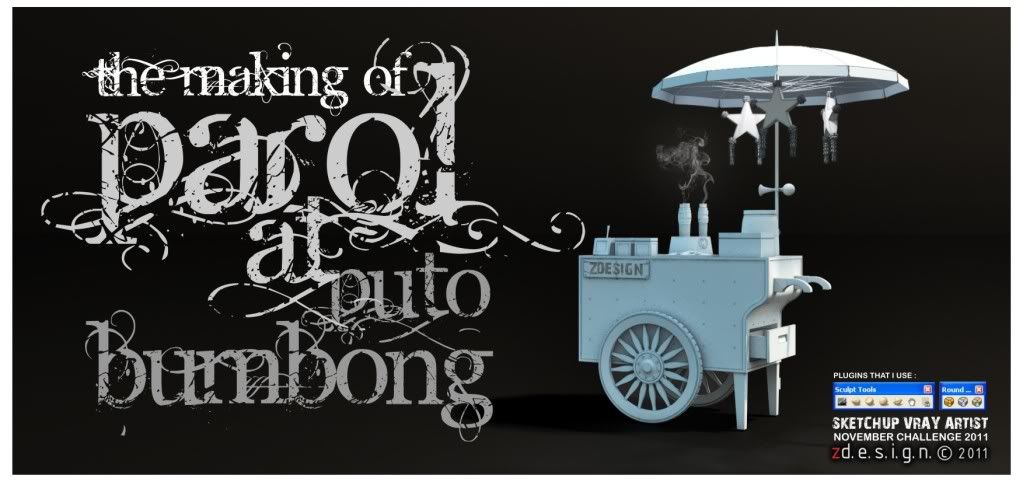Here is the Making of Zernan Suarez winning entry; Parol at Puto Bungbong. Visit Zernan Suarez blogsite to see his work and at the same time download the model HERE.
Here is Zernan's excerpt about this model.
The parol or lantern is one of the most iconic and beloved symbols of the holiday. The earliest parols were traditionally made from simple materials like bamboo sticks, Japanese rice paper (known as "papel de Hapon") or crepe paper, and a candle or coconut oil-lamp for illumination; although the present day parol can take many different shapes and forms. The most base form of the lantern is a 5-pointed star with two "tails" at the lower two tips. Other variations are 4, 8, 10 pointed stars with the rarer 6, 16 and so on pointed stars. The parol is also traditionally made of lacquered paper and bamboo, but others are made of cellophane, plastic, rope, capiz shell and a wide variety of materials. Making parols is a folk craft, and most Filipino kids have tried their hand at making a parol at one time or another, maybe as a school project or otherwise. The most basic parol can be easily constructed with just ten bamboo sticks, paper, and glue. These lanterns represent the Star of Bethlehem that guided the Magi, also known as the Three Wise Men or Three Kings (Tatlong Hari in Tagalog).
Puto Bumbong, Traditionally made from a special variety of heirloom sticky or glutinous rice called Pirurutong which has a distinctly purple color, soaked in salted water and dried overnight and then poured into bumbong or bamboo tubes and then steamed until done or steam rises out of the bamboo tubes. It is served topped with butter or margarine and shredded coconut mixed with sugar.
Puto bumbong is the most sought after delicacies at Christmas time. During the simbang gabi or the Christmas Eve mass, people would line up to their favorite stalls outside the church just to have a taste of this favorite Pinoy delicacies.
Here is Zernan's excerpt about this model.
The parol or lantern is one of the most iconic and beloved symbols of the holiday. The earliest parols were traditionally made from simple materials like bamboo sticks, Japanese rice paper (known as "papel de Hapon") or crepe paper, and a candle or coconut oil-lamp for illumination; although the present day parol can take many different shapes and forms. The most base form of the lantern is a 5-pointed star with two "tails" at the lower two tips. Other variations are 4, 8, 10 pointed stars with the rarer 6, 16 and so on pointed stars. The parol is also traditionally made of lacquered paper and bamboo, but others are made of cellophane, plastic, rope, capiz shell and a wide variety of materials. Making parols is a folk craft, and most Filipino kids have tried their hand at making a parol at one time or another, maybe as a school project or otherwise. The most basic parol can be easily constructed with just ten bamboo sticks, paper, and glue. These lanterns represent the Star of Bethlehem that guided the Magi, also known as the Three Wise Men or Three Kings (Tatlong Hari in Tagalog).
Puto Bumbong, Traditionally made from a special variety of heirloom sticky or glutinous rice called Pirurutong which has a distinctly purple color, soaked in salted water and dried overnight and then poured into bumbong or bamboo tubes and then steamed until done or steam rises out of the bamboo tubes. It is served topped with butter or margarine and shredded coconut mixed with sugar.
Puto bumbong is the most sought after delicacies at Christmas time. During the simbang gabi or the Christmas Eve mass, people would line up to their favorite stalls outside the church just to have a taste of this favorite Pinoy delicacies.



thank's again sir...
ReplyDeleteThe blog was removed!!!!
ReplyDelete3 Studies SHOW How Coconut Oil Kills Belly Fat.
ReplyDeleteThe meaning of this is that you literally kill fat by eating Coconut Fats (also coconut milk, coconut cream and coconut oil).
These 3 studies from major medicinal journals are sure to turn the conventional nutrition world around!